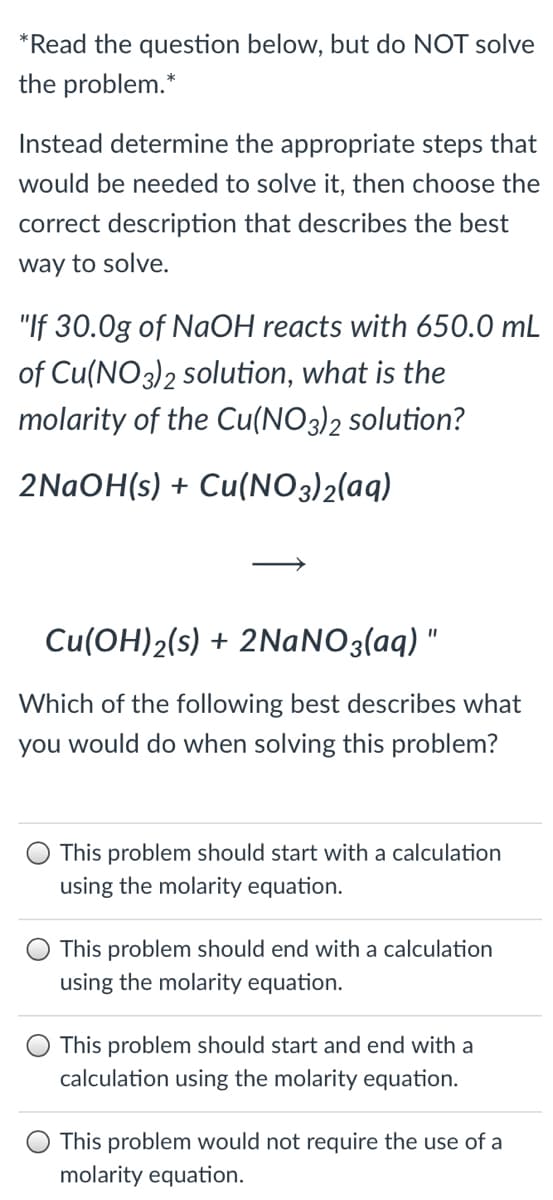*Read the question below, but do NOT solve the problem.* Instead determine the appropriate steps that would be needed to solve it, then choose the correct description that describes the best way to solve. "If 30.0g of NaOH reacts with 650.0 mL of Cu(NO3)2 solution, what is the molarity of the Cu(NO3)2 solution? 2NaOH(s) + Cu(NO3)2(aq) Cu(OH)2(s) + 2NaNO3(aq) " Which of the following best describes what you would do when solving this problem? This problem should start with a calculation using the molarity equation. This problem should end with a calculation
*Read the question below, but do NOT solve the problem.* Instead determine the appropriate steps that would be needed to solve it, then choose the correct description that describes the best way to solve. "If 30.0g of NaOH reacts with 650.0 mL of Cu(NO3)2 solution, what is the molarity of the Cu(NO3)2 solution? 2NaOH(s) + Cu(NO3)2(aq) Cu(OH)2(s) + 2NaNO3(aq) " Which of the following best describes what you would do when solving this problem? This problem should start with a calculation using the molarity equation. This problem should end with a calculation
Chemistry & Chemical Reactivity
10th Edition
ISBN:9781337399074
Author:John C. Kotz, Paul M. Treichel, John Townsend, David Treichel
Publisher:John C. Kotz, Paul M. Treichel, John Townsend, David Treichel
Chapter22: The Chemistry Of The Transistion Elements
Section22.7: Colors Of Coordination Compounds
Problem 1.3ACP
Related questions
Question

Transcribed Image Text:*Read the question below, but do NOT solve
the problem.*
Instead determine the appropriate steps that
would be needed to solve it, then choose the
correct description that describes the best
way to solve.
"If 30.0g of NaOH reacts with 650.0 mL
of Cu(NO3)2 solution, what is the
molarity of the Cu(NO3)2 solution?
2NAOH(s) + Cu(NO3)2(aq)
Cu(OH)2(s) + 2NANO3(aq) "
Which of the following best describes what
you would do when solving this problem?
This problem should start with a calculation
using the molarity equation.
This problem should end with a calculation
using the molarity equation.
This problem should start and end with a
calculation using the molarity equation.
This problem would not require the use of a
molarity equation.
Expert Solution
This question has been solved!
Explore an expertly crafted, step-by-step solution for a thorough understanding of key concepts.
Step by step
Solved in 2 steps with 1 images

Knowledge Booster
Learn more about
Need a deep-dive on the concept behind this application? Look no further. Learn more about this topic, chemistry and related others by exploring similar questions and additional content below.Recommended textbooks for you

Chemistry & Chemical Reactivity
Chemistry
ISBN:
9781337399074
Author:
John C. Kotz, Paul M. Treichel, John Townsend, David Treichel
Publisher:
Cengage Learning

Chemistry & Chemical Reactivity
Chemistry
ISBN:
9781337399074
Author:
John C. Kotz, Paul M. Treichel, John Townsend, David Treichel
Publisher:
Cengage Learning